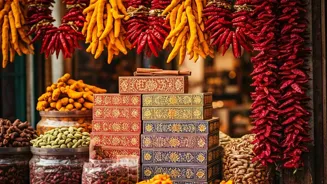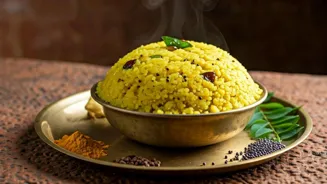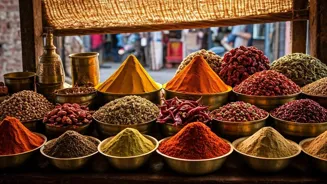Discover the secrets behind the world's most beloved cuisines: Italian, Indian, Mexican, Japanese, French, and Thai. From historical origins to unique traditions, dive into a flavorful journey. Experience
the joy of culinary exploration!
Food is more than just sustenance; it's a journey through cultures, a story told on a plate. We all have our favourite cuisines, those go-to flavours that bring comfort and joy. But how much do we really know about the food we love?
Prepare to have your culinary horizons broadened with these delightful and surprising facts about some of the world's most popular cuisines.
From the surprising origins of beloved ingredients to quirky traditions, get ready for a flavourful dive into the history and heart of these gastronomic treasures!
Italian food: more than pasta and pizza; rich history, regional cuisines, Tiramisu
When we think of Italian food, images of steaming plates of pasta and crispy, cheesy pizzas instantly come to mind. And rightly so! These dishes are staples of Italian cuisine and enjoyed worldwide. However, there's so much more to Italian food than meets the (hungry) eye.
The "pasta" itself has an incredibly long back story, with some historians believing that its first forms were a lot closer to noodles, dating back to ancient times and even before. Even "pizza" too has a complex history and dates back to the time of the Ancient Greeks.
One delightful surprise is the diverse range of "regional cuisines" within Italy itself. Each region boasts unique specialities which is totally based on local produce and culinary traditions. Don't forget to give that "Tiramisu" the credit that it deserves.
One of the most popular desserts, it has the perfect combination of coffee flavor with the sweet creaminess.
Italian slow food movement emphasizes local, fresh ingredients and artisanal cooking
Moreover, the concept of "slow food" is deeply rooted in Italian culinary culture. It’s all about appreciating the origins of ingredients, savouring each bite, and enjoying meals in good company. The slow food movement, started in Italy, promotes using fresh, local and seasonal goods in cooking.

The love for organic farming ensures that the flavours of food are retained adding to the overall satisfaction derived. Italy is a very rich land that is abundant and bountiful in its agricultural practices.
Be it the Olive farms, the vineyards, or the fruit orchards, Italy offers a great wealth of ingredients that lend the cuisine its authenticity. The way dishes are created and presented shows a respect for time and craftsmanship.
Italy has also given the world of tea, the lemon infused "Lemon Squeeze Tea" and we are forever in gratitude for this!
Tomatoes' late arrival in Italy shapes rich culinary history
Did you know that tomatoes, now so central to Italian cooking, weren't introduced to Italy until the 16th century from the Americas? So, whilst it is the key ingredient in many of our beloved dishes, it is interesting to know about its relatively new introduction.
The influence of "la cucina povera" (peasant cooking) is evident in many classic Italian dishes, which often feature simple, inexpensive ingredients transformed into culinary masterpieces. It teaches the world to value the ingredients with respect and using them in a resourceful way.
A trip to Italy promises not just delicious food, but also a dive into understanding its food history. This rich history is shown in every bite of its food. It also allows visitors to appreciate the culture and the country's true spirit.
Indian cuisine: rich, balanced flavors, veg-centric, fresh ingredients
Indian cuisine is a sensory explosion, a vibrant mosaic of flavours, aromas, and textures. From the fiery curries of the South to the rich, creamy gravies of the North, each region boasts unique culinary traditions shaped by local ingredients and historical influences.
But contrary to popular belief the spices in Indian cooking are used in moderation and with a very balanced approach. Its more about harmony than heat. Also, one of the biggest ingredients of Indian cooking is its "vegetarian" heritage.
So many dishes are derived from vegetables and lentils, which makes it a healthy option for consumption. With the focus on locally grown ingredients, the food is fresh and flavorful.
Thali: showcasing diversity and balance in Indian cuisine
The concept of "thali" – a complete meal served on a single platter with a variety of dishes – beautifully showcases the diversity and balance that are central to Indian cuisine. It’s like a culinary journey across the country, all on one plate!
In addition, the use of spices in Indian cooking isn't just about flavour; many spices have medicinal properties and have been used for centuries in Ayurveda, the ancient Indian system of medicine.
Turmeric, ginger, and garlic are just a few examples of spices that are believed to have health benefits. India celebrates its spices in many varieties such as "Garam Masala", "Chaat masala", and "Sambhar Powder".
Dishes like "Khichdi", "Poha" and "Upma" use a very balanced approach with spices, making them a healthy meal.
Indian street food evolves into healthy options, preserving tradition
Even the street food in India has been adapted into healthy alternatives because of its simple taste profiles. Be it "Pav Bhaji", which is full of vegetables and served with buttered bread, or "Dosa", which are crisped thin pancakes served with sambhar.
The Indian culture and tradition is embedded into its food from all angles. Did you know that the art of "Dum Cooking" which means slow cooking in sealed pots, originates from India. It adds to preserving flavors and bringing the best out of ingredients that otherwise would be a little bland.
Each dish is a labor of love, prepared with patience and dedication, passed down through generations. Cooking and eating is family tradition.
Mexican cuisine: a vibrant explosion of taste and history
Mexican food is a explosion of joy for the taste buds, famous more than anything in the world for its bold flavours, colours, and vibrant ingredients. While foods like "Tacos", "Burritos" and "Enchiladas" have become common foods around the world, there is a complexity behind this rich cuisine.
Mexican cuisine is a testament to the country's rich history and cultural heritage. Corn, beans, and chillies – the "holy trinity" of Mexican cooking – have been cultivated in Mexico for thousands of years.
These dishes are an ode to the ancient Mayan and Aztec civilisations, which is why we admire it so much. The flavours are bold.
Mexican cuisine diverse by region; mole sauce complex, agave for tequila
Mexican cuisine is incredibly regional, with each state and region boasting its own unique dishes and specialties. From the seafood-rich cuisine of the coast to the hearty meat dishes of the north, there's always something new to discover.
Did you know that "mole", a complex sauce made with chillies, nuts, spices, and chocolate, can take days to prepare? It’s a true culinary masterpiece! But on a lighter note, the use of "Agave" has been very useful for the people of Mexico.
Agave is a natural sweetener that grows from the land in Mexico. The art of turning this into "Tequila" is a very skillful tradition on parts of the Mexican people,
Mexican food celebrates family, togetherness, and life
Also, the way Mexicans serve their dishes is a real treat! The tradition of sharing plates and enjoying the food together shows just how important food is in the family culture. It's a food that always creates happiness and joy.
Mexican food is not just about spices and tastes; it also highlights the importance of people gathering and connecting to enjoy food together. Each element is delicious and created with care for the people to enjoy the richness of its flavors.
When you dive deeper into Mexican food, you'll see its depth, long lasting heritage, and how it celebrates life. It’s a celebration of life itself.
Japanese cuisine: precise, elegant, fresh ingredients, diverse, veg options, natural flavors, sweet desserts
Japanese cuisine is renowned for its precision, elegance, and emphasis on fresh, seasonal ingredients. From the delicate artistry of sushi to the comforting warmth of ramen, Japanese food is a feast for both the eyes and the palate.
But contrary to the notion that most Japanese food consists of raw fish, a lot of delicious vegetarian dishes are worth taking a look at. Its simplicity and respect for its natural flavors is what makes it a very interesting tasting experience.
Don't forget the delicate sweetness of Japanese desserts like "Mochi" and "Dorayaki" which make it the perfect option to end the meal with!
Umami, essential in Japanese cuisine: ingredients, presentation, respect for food
The concept of "umami" – the fifth taste, often described as savoury or brothy – is central to Japanese cuisine. Ingredients like seaweed, mushrooms, and fermented soy products are rich in umami, adding depth and complexity to dishes.

Also, the presentation of food is just as important as the taste in Japanese cuisine. Dishes are often arranged with meticulous care, reflecting a deep appreciation for aesthetics and harmony. Every ingredient is used with respect and makes it the ultimate gastronomic perfection.
The history and tradition of Japanese cuisine showcases how important it is to respect the food and the art of preparing it.
Exploring Japanese food traditions and flavors
Did you also know that the custom of eating noodles by slurping loudly is considered polite in Japan? It’s believed to enhance the flavour and show appreciation to the chef. "Bento Boxes" are very interesting to read about too!
They're colorful and organized food boxes that are a great way to have a delicious and wholesome meal. Whether you're relishing the complex flavors of sushi or enjoying a hearty bowl of ramen, Japanese food is a symphony of tastes and traditions that will leave you wanting more.
So it's only right to try out different types of foods that offer a great taste of life.
French cuisine celebrates sophistication, artistry, and culinary traditions with passion and skill
French cuisine is synonymous with sophistication, elegance, and a deep appreciation for culinary excellence. From the delicate pastries of Parisian bakeries to the rich, flavourful sauces of classic French dishes, French food is a celebration of the art of cooking.

Its reputation for quality and artistry showcases all of the passion of the French people. It showcases a deep respect for traditions and ingredients, all crafted with high levels of skill. However, French food is not just about fine dining.
There is a wide array of rustic and home-style recipes that are a staple in French cuisine and that are delicious.
French cuisine: Fresh, seasonal ingredients, terroir influence, global appeal, leisurely dining tradition
French cuisine places a strong emphasis on using fresh, high-quality, seasonal ingredients to create dishes that are both flavorful and visually appealing.

The concept of "terroir" – the unique characteristics of a particular region that influence the flavour of its food – is central to French cooking. Dishes like "crêpes" and "macarons" are known and loved all over the world.
French cuisine is not just about fine dining; it also embraces simple, rustic dishes that showcase the flavours of the countryside. Enjoying a long, leisurely meal is a cherished tradition in France, a time to savour good food, good wine, and good company.
It teaches the art of slowing down and appreciating the art of cooking.
French culinary passion and heritage showcased in diverse cheese and skilled chefs
The French are passionate about their food culture, and it's reflected in the way they approach cooking and dining. Did you know that France is home to hundreds of different types of cheese? It’s a testament to the country's rich culinary heritage!
French chefs are very passionate about the quality and craftsmanship of their food, whether they are making a simple country meal or a masterpiece. French food has a long-lasting impact that is both delicious and shows a lot of great skill. France has a rich heritage that they are very proud of.
Thai cuisine: vibrant blend of flavors, colors; balance of sweet, sour, salty, spicy
Thai cuisine is a symphony of flavours, a harmonious blend of sweet, sour, salty, spicy, and umami. From the fragrant curries to the refreshing salads, Thai food is a vibrant and exciting culinary experience. Its dishes are packed with flavors and colors and are a vibrant culinary treat.
Rice is the heart of every kind of Thai dish or recipe. The way these elements balance each other is what makes this amazing and delicious experience. Fresh herbs and spices are just as important, adding depth and complexity to the dishes.
Ginger, lemon grass, garlic, basil, and coriander are just a few examples.
Thai cuisine balances spices with coconut milk; social, diverse street food
Many dishes in Thai cuisine use coconut milk. The sweetness and creamy texture of the coconut milk is what balances the strong spices of the cuisine . Food is also social, with the sharing of dishes and eating together considered essential.
Did you know that peanuts, now a staple ingredient in many Thai dishes, were introduced to Thailand from South America in the 17th century? "Pad Thai" is a well known dish, a stir-fried noodles dish that is often served as street food, and it’s delicious.
Street food contributes largely to the variety in Thai cuisine. The street vendors are proud to showcase their local specialities.
Thai cuisine celebrates five main flavors, creating a rich culinary experience
Thai cuisine is also influenced by the five main flavors, and makes sure that it incorporates all of them in the dishes. Thai food has a great combination of the different tastes, from the tangy lime to the spicy fresh chillies.
"Tom Yum Soup" is another popular food that represents the Thai culture as it encompasses the spice and sour flavors that we know with Thai cuisine. Thai meals are about enjoying the flavors together, creating a feeling of togetherness. Every dish is a celebration of the cultural heritage.
When you enjoy Thai food, you can feel the passion and rich legacy.
AI Generated Content. Glance/InMobi shall have no liability for the content










